Final report for FNC17-1103
Project Information
Ohio Valley Hops, LLC is a family owned and operated hop farm located in Warren County, Ohio. We grow eight varieties of hops on one and a half acres (about 1500 plants). I led a team which founded the Ohio Hop Growers Guild, the association of hop growers in Ohio which currently has over 50 members, and have served as a director since its founding. I serve as Ohio’s representative to the Hop Growers of America Small Grower’s Council, and have been a guest speaker on Ohio Hops at the annual conferences of both the Ohio Craft Brewers Association and the Ohio Hop Growers Guild. We own a mobile hop harvester, and in addition to harvesting our own hops, travel around the region to do custom harvesting for other growers. Before receiving the grant, we practiced IPM, used compost and composted manure as much as possible, grew companion plantings to attract beneficial insects, and worked closely with Ohio State University on research efforts to advance hop growing in Ohio.
We built a mobile hop dryer that will quickly dry hops to national quality standards for processing, storage and sale, while allowing sharing among collaborating growers, reducing the need for all growers to build fixed facilities, saving them money, and improving crop quality and marketability. Our problem was to find a way to quickly dry hops to the ideal moisture content for processing, while reducing individual farmer investment by creating a shareable resource. Drying hops is time sensitive from start to finish. The sooner that harvested hops can begin and finish the process, the higher the quality, and more marketable. Hops (like any vegetative product) begin to break down as soon as they are picked, potentially resulting in off flavors that reduce their marketability. Conversely, immediate entry into the drying process and rapid completion prevents damage, and maximizes oil and acid retention that give hops the flavors and aromas desired, improved pelletability and storage, and thus sales potential and price point. Many growers rely on other farmer’s drying facilities, increasing travel and time between harvest and drying. Farmers who have immediate access can produce a much higher quality hop than those who don’t. Several growers in Ohio also process hops into pellets, the form required by brewers. These processors report most hops they receive are not dry enough, requiring them to be re-dried, further degrading their quality. We know of one commercially available small-scale dryer; a fan unit with blueprints for the dryer that costs $3800, materials not included. Several growers have built fixed drying facilities which allow on-farm drying which have proven to be effective and efficient. However, they cost several thousand dollars and permanently take up floor space. Practically and financially, not every farm needs to tie up space and money in a dryer. Sharing is viable, since drying takes ~48 hours, and Ohio’s harvest starts in the southwest in July and continues through September in the northeast with about a seven to ten day harvest window per variety. It is practical that numerous growers could use one mobile dryer.
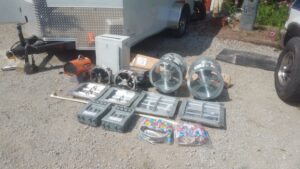
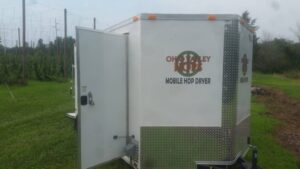
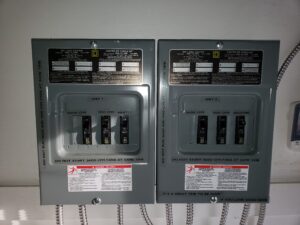

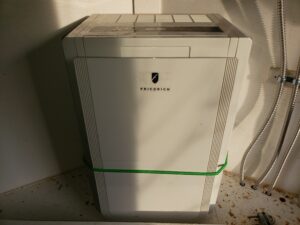
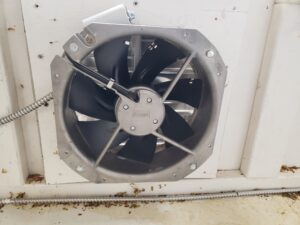
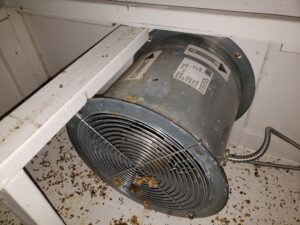
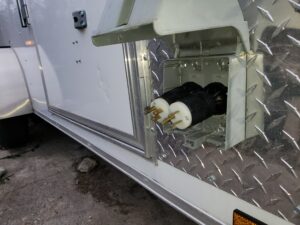

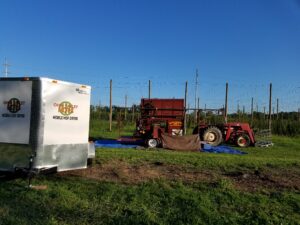
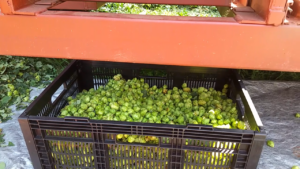
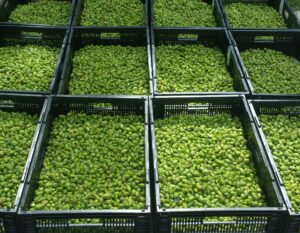
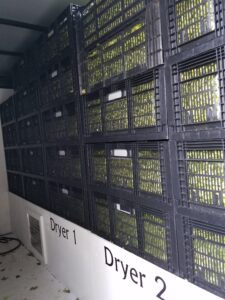
We proposed to build a prototype mobile hop dryer that incorporates best drying practices from small-scale hop growers. It would facilitate immediate drying after picking. It will be shared among a group of growers who manage their harvest dates to maximize utilization, eliminate the cost and inefficiency of a fixed facility, while improving the quality and marketability of their crop. The design could be replicated and shared collaboratively by other groups of growers.
It was built in an enclosed trailer, with a two-step, 48 hour drying process involving high volume air movement for initial drying and then lower volume conditioned air for finishing, powered by a generator for complete mobility, with food safe materials and practices as required. Although using proven drying techniques, we tested to ensure this design is able to accomplish its intended goal of drying the crop to accepted moisture content standards within approximately 48 hours. It performed well- with a complete load of over 1000 pounds of hops, the hops were dried and conditioned in less than 48 hours. Smaller loads took as little as 24 hours.
We cooperatively shared the dryer with 4 Ohio based farmers the first year to test scheduling and sharing, and shared with 5 second years, determining that the optimal number of farms that can be served by a mobile hop dryer is even more than that.
We proposed to use a number of factors to determine success.
Crop quality. We will gather and compare data between hops dried in the mobile dryer and those dried by other means. We will gather data from farmers who we dry for, comparing 2016 crop testing data with 2017 data where we can; and with larger farms who are willing (including our farm), have them split their crop with their existing process and the mobile dryer. Items we will pay particular attention to will include total drying time, and lab test results that include the Hop Storage Index (HSI) -- which indicates how long the hops can be stored and is a direct measure of the quality of the drying process -- as well as alpha acid and beta acid content, which are critical to the science and art of brewing, and are greatly impacted by the quality of the drying process. We will tabulate data from each farm on spreadsheets for analysis.
Grower perception. We will construct a survey that gathers grower perceptions about ease of scheduling, ease of use, quality of process, quality of product, brewer satisfaction with product, and likelihood of future use. We will also follow up after they sell their hops regarding feedback from their brewer customers about quality.
Processor perception. We will construct a survey of processors about the quality of raw product they receive, and its readiness for pulverizing and pelletizing, comparing those who dried using the mobile hop dryer and those who did not.
We will repeat this process in year two, also looking for increased demand for the mobile hop dryer and comparing the data to year one. A key measure of success in year two would be another farmer or group of farmers replicating the mobile dryer.
Our research conclusions are hindered by the fact that we were the only farm that used the dryer two consecutive years. Two of our cooperators in year one liked the system so much that they built their own fixed dryers, and so did not require usage. Another grower stopped growing hops due some life changes, and the fourth had a terrible growing year and didn't have enough hops to justify harvest. That said, we had five new farmers use it the second year.
Crop Quality. Both years, our users reported their hops dried well within the projected time and were ready for processing with no further drying required. The second year, we changed our heating system to a thermostatically controlled electric heater set to 105-100 degrees, and it further reduced drying time. Using our own lab testing results, we found that our labs were steady both years, and well within the industry standards for hop storage index (HSI), and alpha and beta acids for each variety dried. We had a slight improvement in HSI in year two, but that may or may not be attributable to faster drying times.
Grower perception. Both years, growers who used the dryer were satisfied with the ease of use, portability, and effectiveness. The first year we provided written instructions through email, but found that not all users read them that year, so the second year we put them on a foam core poster and mounted them inside the trailer so they were easily accessible, and all users were able to have them at hand through the whole process. Transport was easy- growers simply picked up the trailer, pulled it to their site, used it and returned it or it was picked up by the next user. A few phone calls or text messages was all that was necessary to facilitate moving it along.
Processor perception. Two Ohio processors pelletized hops dried in the mobile dryer. From many discussions over the last several years, processors biggest gripe is that growers do not dry their hops evenly or thoroughly. That was not the case with the mobile dryer. Simply following provided instructions on bin rotation, use of heat and air, and moisture testing led all users to get their hops in the 8-10% moisture range, ideal for further processing and packaging.
Adoption by other growers. I have provided plans, materials lists and talked with five hop growers (from FL, CT, OH, KY and NY) who have indicated they are going to build a similar system, but at this time don't know if they followed through. I have had further interest from growers at showings.
Research
Hop growing in the Midwest has increased at a steady pace in terms of acreage and farmers for the last several years. As our plants have matured and we are hitting full production, the realities and necessities of processing are foremost on growers’ minds. Enough growers have purchased mobile and fixed harvesters, hammer mills, pelletizers and vacuum packagers to satisfy the need for those services for other growers, but drying is something that must happen as soon as possible, on farm, to maximize quality. With improved quality and increasing quantity, hop growing can be a sustainable crop that provides an alternative crop and additional income to many small farmers. Since it is relatively expensive to begin growing hops, and not feasible or necessary for every grower to own all of the processing equipment, the mobile hop dryer should provide a practical solution to a critical step in the quality process, increasing the demand for locally grown hops and sustaining. Since we are taking a proven drying design and adapting it for mobility, it is very likely that others could replicate it, and we will widely distribute our bill of materials, plans, and instructions. At the costs we project, it is very likely that consortiums of farmers, such as a cooperative, or a guild such as Ohio has, could pool resources to build one or more and share them or rent them at a very reasonable rate.
We will use a number of factors to determine success.
Crop quality. We will gather and compare data between hops dried in the mobile dryer and those dried by other means. We will gather data from farmers who we dry for, comparing 2016 crop testing data with 2017 data where we can; and with larger farms who are willing (including our farm), have them split their crop with their existing process and the mobile dryer. Items we will pay particular attention to will include total drying time, and lab test results that include the Hop Storage Index (HSI) — which indicates how long the hops can be stored and is a direct measure of the quality of the drying process — as well as alpha acid and beta acid content, which are critical to the science and art of brewing, and are greatly impacted by the quality of the drying process. We will tabulate data from each farm on spreadsheets for analysis. Initial results (anecdotal and lab result) is positive.
Grower perception. We will construct a survey that gathers grower perceptions about ease of scheduling, ease of use, quality of process, quality of product, brewer satisfaction with product, and likelihood of future use. We will also follow up after they sell their hops regarding feedback from their brewer customers about quality. Initial grower feedback is very positive, with all wanting to use it again next year, and others already asking to schedule next year, and beer ratings from the Untappd beer rating app comparing beer brewed with these hops is better than last years beers.
Processor perception. We will construct a survey of processors about the quality of raw product they receive, and its readiness for pulverizing and pelletizing, comparing those who dried using the mobile hop dryer and those who did not. Feedback this year from the processor who pelletized these users hops was very positive.
We will repeat this process in year two, also looking for increased demand for the mobile hop dryer and comparing the data to year one. A key measure of success in year two would be another farmer or group of farmers replicating the mobile dryer.
Educational & Outreach Activities
Participation Summary:
I have been able to show/demonstrate the mobile hop dryer at five events, and included pictures/video/information about it in three other presentations. First, we showed at at the Ohio Hop Growers Guild's semi-annual meeting in Athens Ohio on July 15, 2017. 47 growers or potential growers attended, and I was able to give a short talk and demonstrate its operation. We participated twice in the Guild's statewide hop yard open house where we had over 60 people visit, where I talked about it and demonstrated it to small groups or individuals. We were one of two sites for the Guild's harvest field day on August 4, 2017. Another 26 growers or potential growers attended this event, where I and another grower taught a seminar on harvest practices, to include drying procedures where I demonstrated the mobile hop grower. I also presented and demonstrated at the Ohio State University's 5th annual Hops Conference in March 2017, with an attendance of 200. I have had well over a dozen farmers/potential farmers visit our farm to discuss production practices, and I always provide a demo. I have also promoted the project on multiple Facebook pages/groups, and on Twitter, where I have tagged NC-SARE. From these posts, I have received many questions and positive feedback.
I was also the guest speaker at two county Ohio Farm Bureau annual meetings (Clinton County and Warren County) to talk about growing hops, and in both presentations showed pictures and video of the dryer, and promoted the concept as I submitted it. It also was displayed at Barn Talk Hops in Wadsworth, OH for the the Medina County Fall Foliage Tour where over 1200 people visited. I have developed a brochure that describes the dryer's operation and benefits to fellow hop farmers.
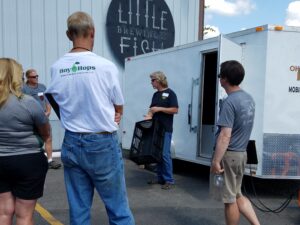
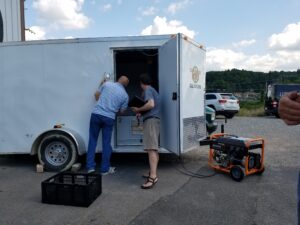
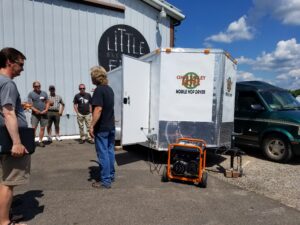
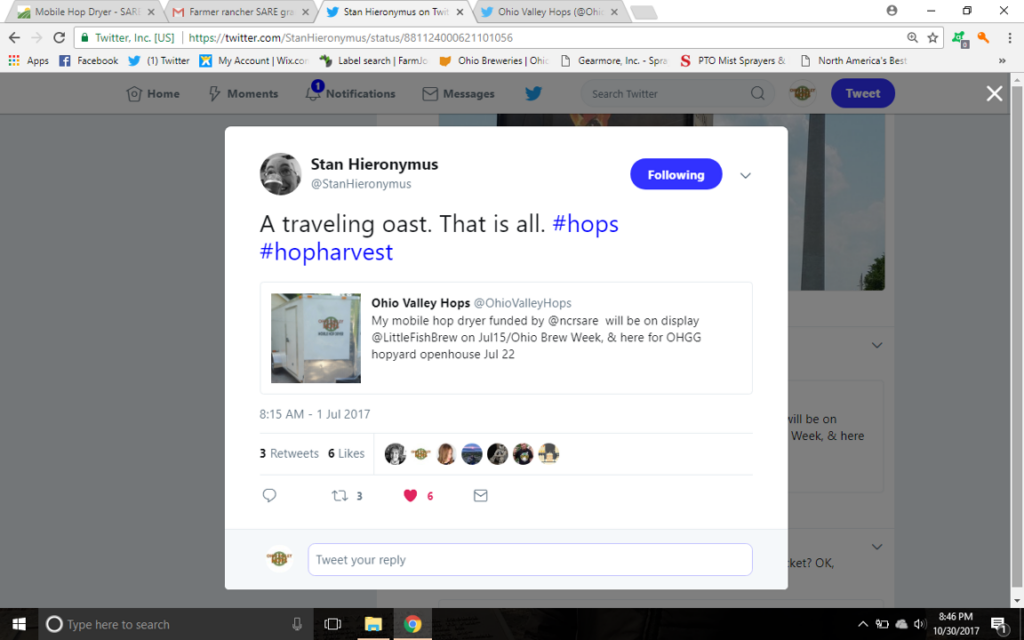
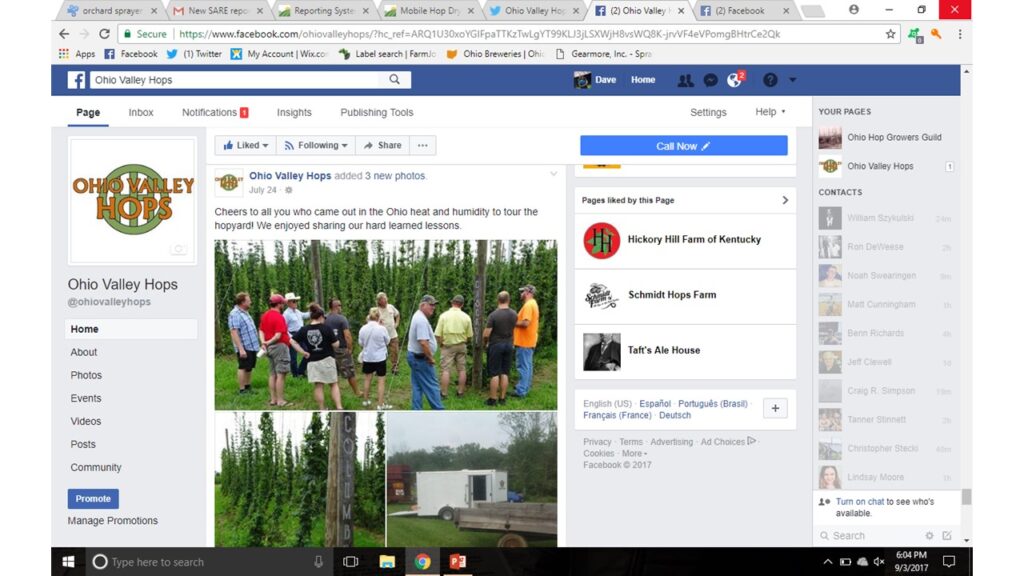
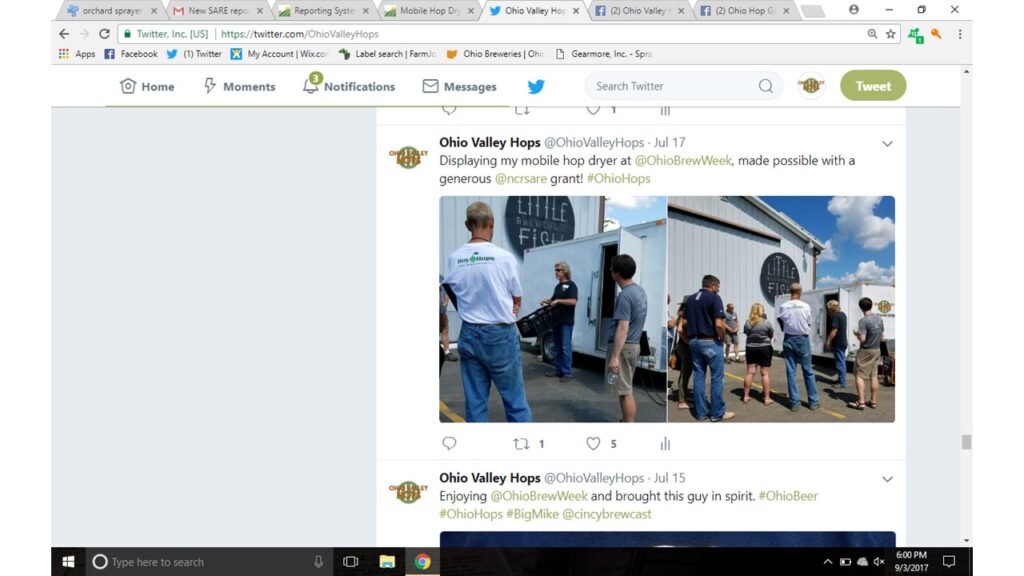
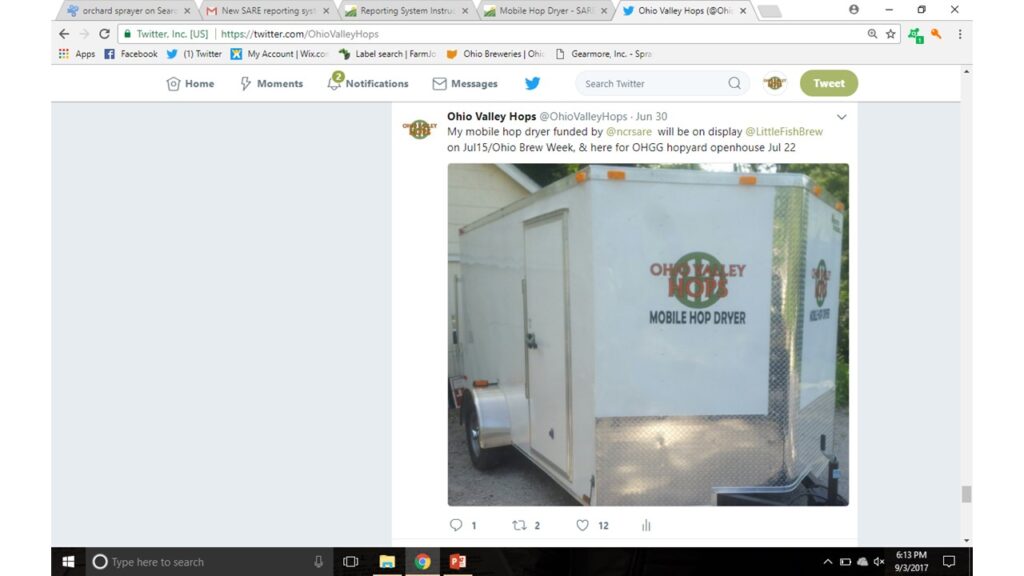
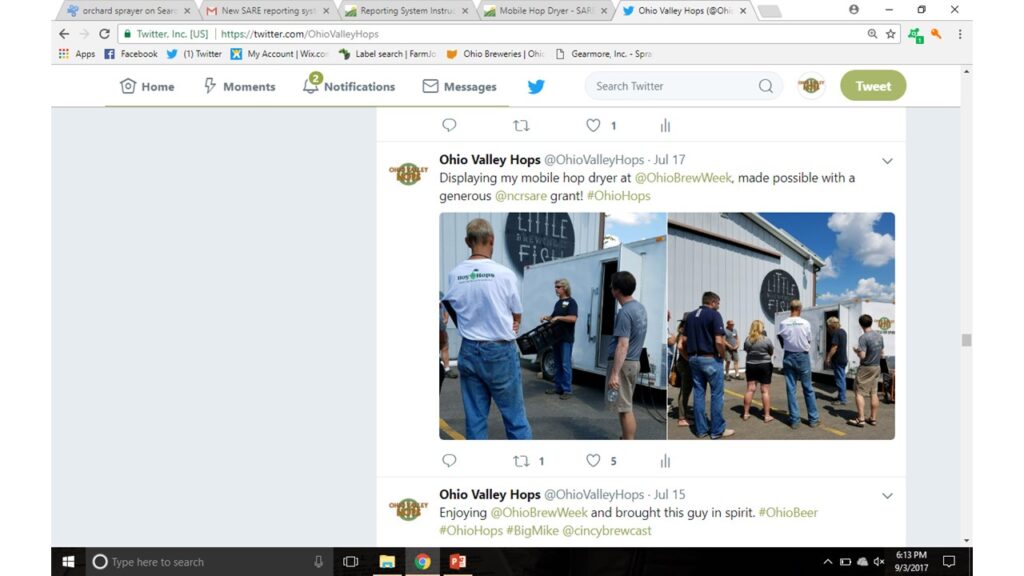
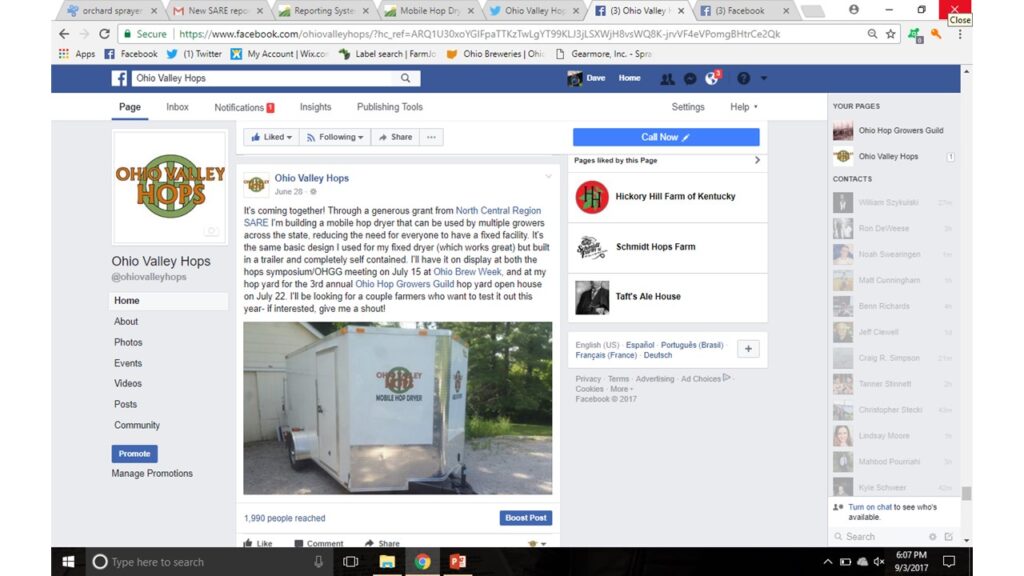
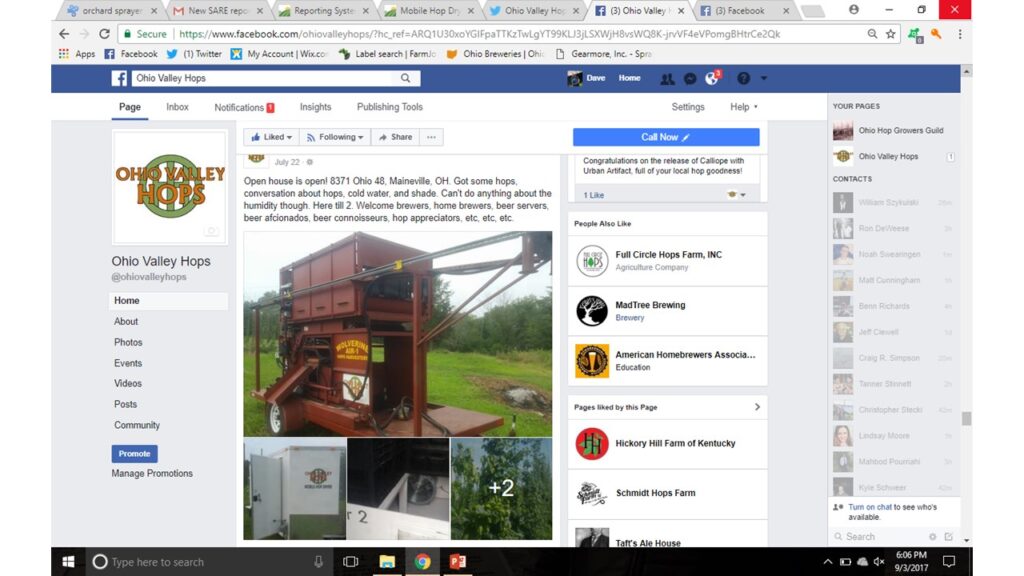

Learning Outcomes
After building this dryer and over two seasons using it, I have learned that the concept works. The dryer works well- our hops dried quickly and evenly and were ready for further processing. We were able to meet our first and second year goals for sharing, and got good feedback on its performance, and some good suggestions which we implemented. We got positive feedback on the concept from fellow hop growers at all of our events. A disadvantage we found is it may not be big enough for growers over a half acre, at least not to do all their hops in one batch, although it would be easy enough to scale it up. It could definitely be built for less by a thrifty grower, by buying a used trailer and some equipment, like the dehumidifier and fans. The harvest baskets make moving the hops from harvester to dryer easy and efficient, but they could be replaced by a larger home made basket setup if the harvesting process was not a concern for the grower. For a group of farmers to share the cost of building one to share, they would need a good relationship between them and clear agreement on cost sharing and maintenance responsibilities. I think it might work better for one grower to build and own a dryer, and to rent it out to interested growers. We learned that its important to make the instructions for use simple, clear and accessible, and even better to give a hands on orientation when possible, although its not difficult to use.
Project Outcomes
I dried my own hops faster the first year than ever before, and even faster in year two. The dryer was very effective at quickly achieving target moisture rates- less than 36 hours. The only time I used my fixed dryer this season is when the mobile dryer was on the road, as the mobile dries faster and more evenly than my barn dryer.
A grower in central Ohio who observed it at a field day was the first test of sharing. He picked it up the week of his harvest (a week after mine) and successfully dried his hops. While it was at his farm, another grower in Northeast Ohio who I harvest for contacted me to see about use. He in turn picked it up as soon as the first grower finished drying, and we were able to load the freshly harvested hops straight from the harvester into the dryer. We completely filled the dryer with nearly 1000 pounds of hops. He especially liked the efficiency of harvesting directly into the drying baskets and moving them straightaway into the dryer. Previously, he had to harvest into tubs, then move them by truck onto makeshift drying racks in a greenhouse some distance away, since he does not have a permanent drying system. The second year, I dried for several different growers, as two of the first year's built their own dryers based on this system. The ease of mobility and different harvest dates for varieties and farms made for easy usage.
A hop grower/processor from northeast Ohio, who has a turnkey hop operation, was very impressed with the dryer. He has processed hops for several years, and has seen a wide range of hop quality and readiness for processing, many of which were not dry enough forcing him to re-dry other's hops (he used this one for that purpose several times). He made positive comments about the design and efficiency. He especially liked the quality and speed of the drying process, as well as the portability of the dryer. Having spent thousands of dollars himself on a dryer that he uses a few weeks each year, he liked the idea of shared equipment. Every user expressed interest in using it again, except for those who built their own systems after using mine.
I know at least three farmers who told me they will build their own versions of a mobile dryer based on this project. I have had contact with at least six growers who at last contact were seriously considering building mobile dryers.
The dryer could be scaled up or down, but up is probably the direction to go. With mature, healthy hops, this dryer will hold about 1/2 acre of hops per load. For a small farm with several varieties of hops with different maturity dates, this will work well; or if harvest dates are staggered by 48 hours or so, a grower could still use this for up to 2 acres, and based on throughput of small mobile harvesters, that would work out about right anyway. The generator was not the necessity I thought it would be- I used it with my hops as proof of principle, but the other growers this year did not require it. Nonetheless it adds flexibility and growers at every demo liked the feature. I originally included a propane heater for added heat in phase 2 drying, but the trailer is so airtight that it ran out of oxygen and shut down in minutes. I replaced it with a thermostatically controlled electric heater which helped speed drying even more the second year.